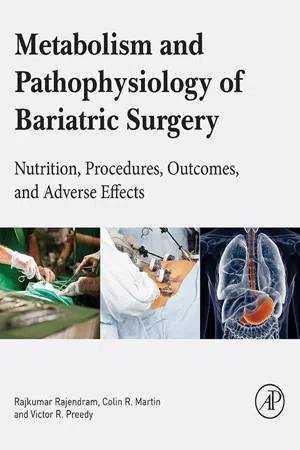Abstract
Patients who undergo bariatric surgery have nutritional treatment regimens that often entail supplementation of micronutrients as well as reductions in dietary energy intake. However, it is important to place these regimens in the context of normative requirements of micro- and macronutrients. Many of the multivitamin and multimineral supplements advocated for use are based on published dietary reference values (DRVs) for general populations in good health. In this chapter we contrast and compare subtleties between DRVs for adults in the United Kingdom, United States, and Japan. We present data for dietary energy, fats, proteins, carbohydrates, and a variety of micronutrients, including vitamins A, B1 (thiamine), B2 (riboflavin), B3 (niacin), B6, B12, C, D, E, and K, folate, pantothenic acid, biotin, calcium, magnesium, phosphorus, sodium, potassium, chloride, iron, zinc, copper, selenium, molybdenum, manganese, chromium, and iodine.
Keywords
Dietary reference intakes; dietary reference values; recommended dietary allowances; minerals; vitamins; multivitamins; multiminerals
List of Abbreviations
AIs adequate intakes
DRIs dietary reference intakes
DRVs dietary reference values
EAR estimated average requirement
LRNI lower reference nutrient intake
RDAs recommended dietary allowances
RNI reference nutrient intake
SACN scientific advisory committee on nutrition
SI safe intake
ULs tolerable upper intake levels
Introduction
Patients who undergo bariatric surgery have specific nutritional requirements before and after surgery [1,2]. These include reducing overall caloric intake before surgery as well as addressing any micronutrient imbalance. Some micronutrient deficiencies arise before surgical procedures as a consequence of obesity per se, and also as a consequence of the presurgical weight loss procedures themselves. For example, as many as 70% of subjects who are about to undergo bariatric surgery are at risk of vitamin D deficiency [1,3]. In one study, 63% of patients were deficient in folate and 98% deficient in vitamin D, though none were deficient in vitamin E prior to surgery [4]. As a consequence of the surgery itself, micro- and macronutrient deficiencies will also arise unless treated [5,6]. For example, fat malabsorption as a consequence of bariatric weight loss procedures will have implications for the status of fat-soluble vitamins A and D, necessitating supplementation in the long term [7,8]. Supplementation with multivitamin and mineral preparations are frequently advocated for use after bariatric surgery [9–13]. An understanding of nutrient supplementations in bariatric surgery is dependent upon an understanding of the normative requirements for the general population.
Micro- and Macronutrients
There are four levels at which dietary components should be considered:
- Level 1. The micro- and macronutrient compositions of foods.
- Level 2. The amount of ingested micro- and macronutrients.
- Level 3. The requirements of micro- and macronutrients.
- Level 4. The status or levels of micro- and macronutrients.
For these four levels of consideration, the amount of ingested nutrients in Level 2 will depend on the micro- and macronutrient compositions of foods and portion size (Level 1). While there are numerous methods for calculating dietary intakes, e.g., with the combined use of food diaries, questionnaires, and food composition tables [14,15], a fundamental question arises as to how much of a particular macronutrient an individual needs, which is the basis of Level 3. The status of micro- and macronutrients (Level 4) will depend on various factors such as genetic variability, the specific forms of the nutrients (e.g., heme and nonheme iron), competitive interactions, and so on (reviewed in Ref. [16]).
In the United Kingdom, the requirements of individuals and populations are termed the dietary reference values (DRVs) [16]. However in many countries, the terms DRVs, recommended values, recommended daily intakes (RDIs), or recommended daily allowance are used interchangeably, even though they mean the same thing, namely imparting advice on what people should consume in order to achieve optimal health and prevent disease. Some systems have also been updated with concomitant name changes. For example, in the United Kingdom the DRVs replaced the UK RDIs of 1979, which in turn replaced the UK recommended daily amounts (RDAs) of 1969 [16]. There may also be some confusion in that terms used in the United Kingdom (DRVs) are not used in the United States. Furthermore, terms previously used in the United Kingdom (RDAs) are presently used in the United States. To address this it is beneficial to document three systems of guidance in detail and define the terms that are often used (Table 44.1).
...